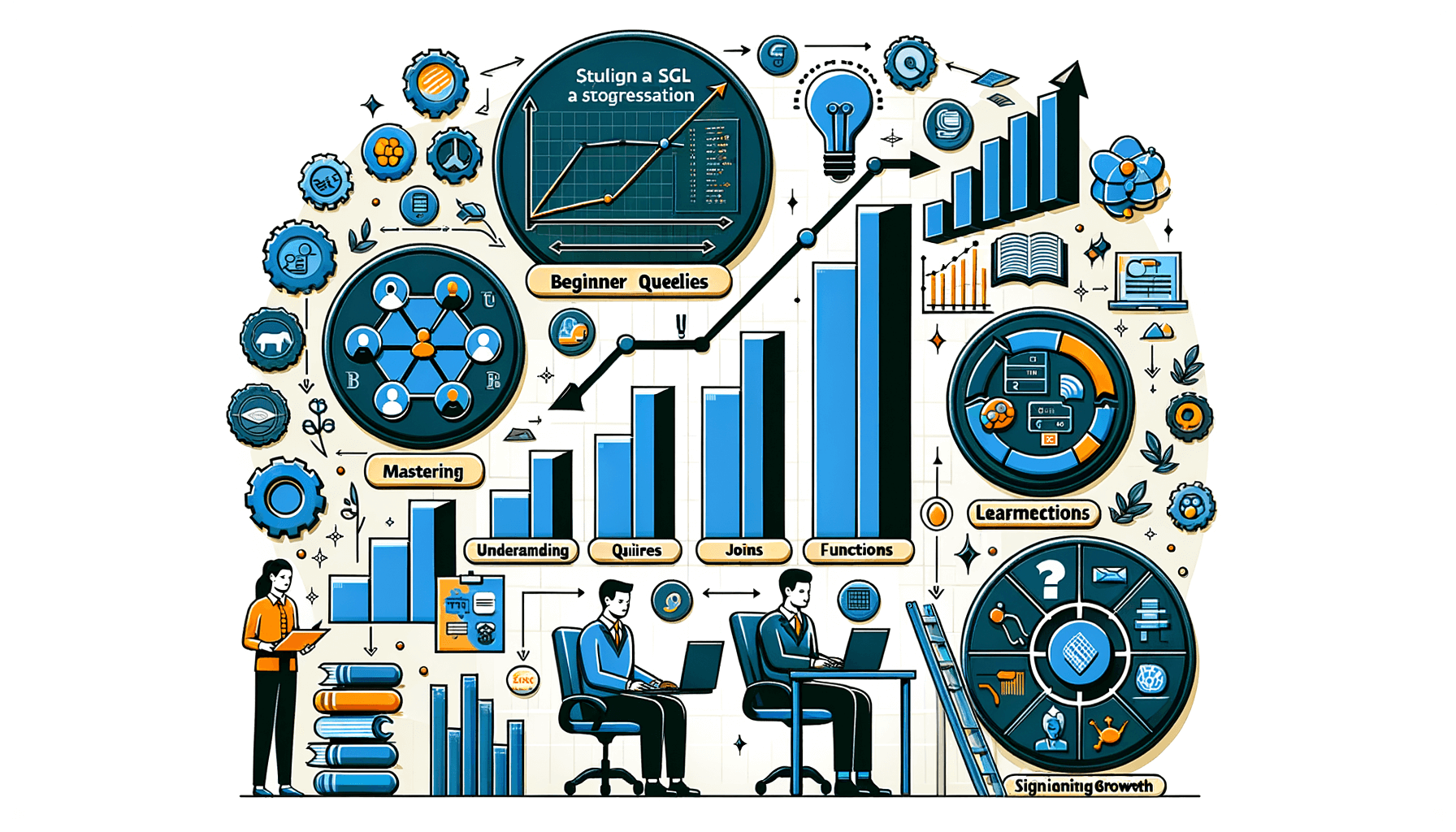A big variety of articles and resources

Breaking Down Data Silos: Key Strategies for the Modern Data Analyst
 Sia Author and Instructor
Learn SQL
Sia Author and Instructor
Learn SQL
8 minute read
Understanding and Tackling Data Silos
The Evolution of Data Silos: A Historical Perspective
Data silos have been a persistent challenge, evolving from isolated file systems to complex digital repositories. Historically, data silos emerged as organizations grew and departments adopted their own methods for storing information. The digital transformation has only intensified the issue, with the proliferation of cloud services and specialized software creating new barriers to data integration.
Unveiling the Culprits Behind Data Silos
Identifying the root causes of data silos is essential for devising effective strategies to dismantle them. Often, these culprits include a lack of standardized processes, proprietary systems, and organizational culture that does not prioritize data sharing. By recognizing these factors, businesses can target their efforts to promote better data practices.
Addressing the Concerns Surrounding Data Silos Today
In today's data-driven landscape, addressing data silos is not just about merging databases—it's about creating an integrated framework that encourages collaboration and data exchange. > By fostering a unified approach to data management, organizations can transform isolated data into actionable insights, driving innovation and growth.
Strategies for Breaking Down Data Silos
Cultivating a Data-Driven Culture for Silo Prevention
To effectively dismantle data silos, organizations must foster a data-driven culture that emphasizes the importance of data accessibility and collaboration across all levels. Encouraging open communication and shared goals can lead to a more cohesive environment where data silos are less likely to form.
Technological Challenges: Aiding the Formation of Data Silos
While technology can inadvertently contribute to the creation of data silos, it also holds the key to their resolution. By adopting technologies that promote integration and interoperability, businesses can reduce the likelihood of siloed information. It's crucial to select tools that align with the company's data strategy and enhance the flow of data.
Implementing Integrated Data Management Systems
The adoption of integrated data management systems is a pivotal strategy for breaking down data silos. These systems should not only facilitate the centralization of data but also ensure its quality and consistency. The following steps are essential for implementation:
- Evaluate existing data infrastructure.
- Identify integration requirements.
- Select a suitable data management platform.
- Migrate data to the new system.
- Train staff on the new system's use.
By methodically addressing each step, organizations can create a robust framework that supports data sharing and eliminates silos.
The Human Element in Data Silo Dynamics
The Human Factor: How People Contribute to Data Silos
While technology plays a significant role in data silos, it is essential to recognize the human factor. Misaligned incentives, lack of data literacy, and resistance to change often contribute to the formation and perpetuation of data silos. Silos can emerge when departments and individuals prioritize their own goals over the sharing and integration of data.
Fostering Collaboration and Communication Across Departments
To overcome this challenge, organizations must foster a data-driven culture that values collaboration, encourages transparency, and promotes the sharing of insights. Breaking down siloed mindsets and incentivizing cross-functional cooperation can prevent the human factor from fueling data silos.
Incentivizing Data Sharing and Transparency
Organizations can incentivize data sharing and transparency by recognizing and rewarding collaborative efforts. This approach not only breaks down existing silos but also prevents the formation of new ones. A table of incentives might include:
| Incentive Type | Description |
|---|---|
| Recognition Awards | Acknowledge individuals or teams for exceptional collaboration. |
| Profit Sharing | Offer a share of profits resulting from data-driven successes. |
| Career Advancement | Provide opportunities for growth to those who champion data sharing. |
By aligning individual goals with organizational data objectives, companies can create an environment where data flows freely and is accessible to all stakeholders.
Leveraging Technology to Connect Disparate Data Sources
Modern Data Architecture and Infrastructure Solutions
In the quest to unify disparate data sources, modern data architecture plays a pivotal role. It provides the blueprint for constructing scalable, flexible, and secure data environments. Infrastructure solutions, such as data lakes and warehouses, support the aggregation of data from various sources, ensuring that it is stored in a manner conducive to analysis and reporting.
Cloud-Based Platforms and Data Integration Tools
The adoption of cloud-based platforms has revolutionized the way organizations handle data integration. These platforms offer a range of services that simplify the process of connecting different data sources, providing tools for ETL processes, real-time data streaming, and more. The use of APIs and middleware further facilitates the integration, allowing for seamless data exchange between systems.
Standardizing Data Formats for Interoperability
To achieve true interoperability, standardizing data formats is essential. This ensures that data from different systems can be understood and used in a consistent manner. Common data standards and protocols, such as JSON, XML, and CSV, enable diverse systems to communicate effectively, reducing the risk of data misinterpretation and enhancing the overall quality of data.
By effectively leveraging technology, organizations can overcome the challenges posed by data silos, leading to improved decision-making and a competitive edge in the market.
Case Studies: Overcoming Data Silos in Different Industries
Current Obstacles in Marketing Analytics
In the realm of marketing analytics, data silos significantly hinder the ability to derive comprehensive insights. Marketers must navigate through fragmented data sources, often leading to incomplete analysis and missed opportunities. To combat this, some companies have started to integrate CRM systems with marketing automation platforms, ensuring a unified view of customer interactions.
Success Stories in Healthcare Data Integration
Healthcare has seen remarkable success in integrating data from disparate systems. Interoperability has been a key focus, with initiatives like the adoption of electronic health records (EHRs) that facilitate data sharing across providers. This has led to improved patient outcomes and streamlined operations. Below is a table showcasing the impact of EHR implementation:
| Metric | Pre-EHR | Post-EHR |
|---|---|---|
| Patient Data Accessibility | Low | High |
| Report Generation Time | Long | Short |
| Healthcare Coordination | Poor | Excellent |
Innovative Approaches in Financial Data Management
Financial institutions are leveraging technology to overcome data silos. They are implementing advanced data management platforms that enable real-time data analysis and reporting. This has resulted in enhanced decision-making and regulatory compliance. A notable trend is the use of AI and machine learning to predict market trends and customer behavior, thus driving innovation in financial services.
Breaking down data silos is not just a technological challenge but a strategic imperative that requires a holistic approach encompassing technology, processes, and people.
Discover how various industries are breaking down data silos and harnessing the power of unified information in our 'Case Studies: Overcoming Data Silos in Different Industries' section. These real-world examples will inspire you to tackle similar challenges within your organization. Don't miss out on the opportunity to enhance your technical skills and knowledge. Visit our website to explore our course catalogue and sign up for the perfect course to become a SQL specialist. Take the first step towards a more integrated data future now!
Conclusion
In conclusion, breaking down data silos is an essential step towards achieving a cohesive data-driven environment that fosters collaboration, enhances decision-making, and unlocks the full potential of an organization's data assets. By cultivating a culture that prioritizes data accessibility and transparency, implementing modern data architectures, and leveraging technology to facilitate integration, companies can dismantle the barriers that silos create. The strategies discussed in this article provide a roadmap for data analysts and organizations alike to navigate the complexities of data silos and emerge with a more unified, insightful, and competitive approach to data analytics. As we continue to advance in the digital age, the ability to effectively manage and analyze data will be a defining factor in the success of businesses across all industries.
Frequently Asked Questions
What are data silos and why are they problematic?
Data silos refer to isolated pockets of data that are controlled by different departments within an organization and are not shared or integrated with other systems. They are problematic because they hinder collaboration, create inefficiencies, and prevent organizations from gaining a holistic view of their data, which can impact decision-making.
How can a data-driven culture help prevent data silos?
Cultivating a data-driven culture involves prioritizing data as a key strategic asset, encouraging open communication and data sharing across departments, and aligning goals to ensure that data is accessible and used effectively. This approach helps prevent the formation of data silos by fostering collaboration and transparency.
What technological challenges contribute to the formation of data silos?
Technological challenges such as disparate software systems, incompatible data formats, and a lack of integrated data management platforms can lead to the formation of data silos. Overcoming these challenges requires investment in modern data architectures and tools that facilitate data integration and interoperability.
How do human factors contribute to the existence of data silos?
Human factors such as departmental territorialism, resistance to change, and a lack of communication can contribute to the persistence of data silos. Addressing these issues involves promoting a culture of collaboration, incentivizing data sharing, and ensuring that all team members understand the benefits of integrated data.
What role does technology play in connecting disparate data sources?
Technology plays a crucial role in connecting disparate data sources by providing the infrastructure and tools necessary for data integration. This includes cloud-based platforms, data integration software, and standardized data formats that enable seamless data exchange and analysis across different systems.
Can you provide examples of overcoming data silos in different industries?
Yes, there are several success stories of overcoming data silos across industries. For example, in healthcare, integrating patient data from different systems has improved patient care coordination. In finance, consolidating data from various trading platforms has enhanced risk management and regulatory compliance.




